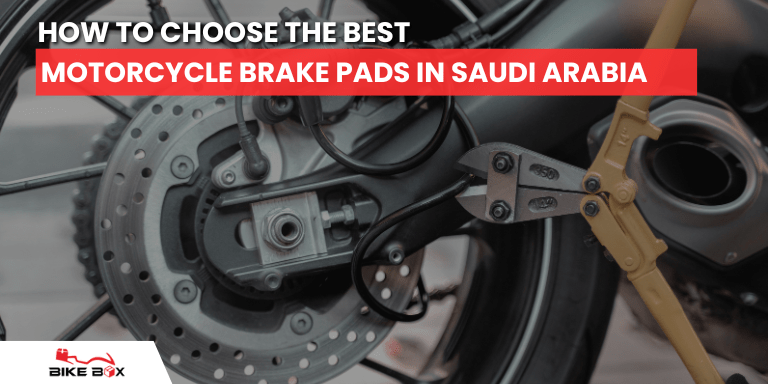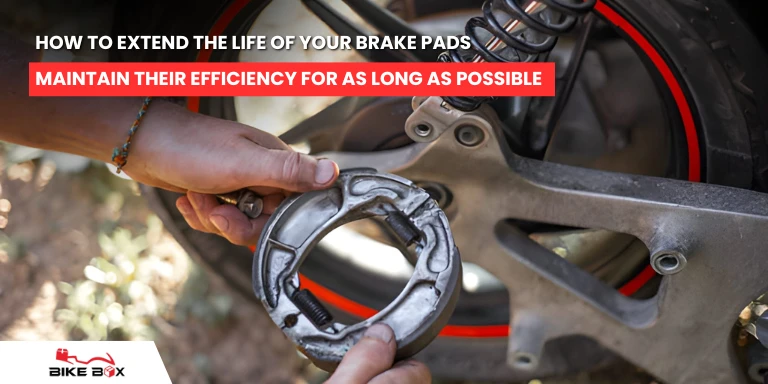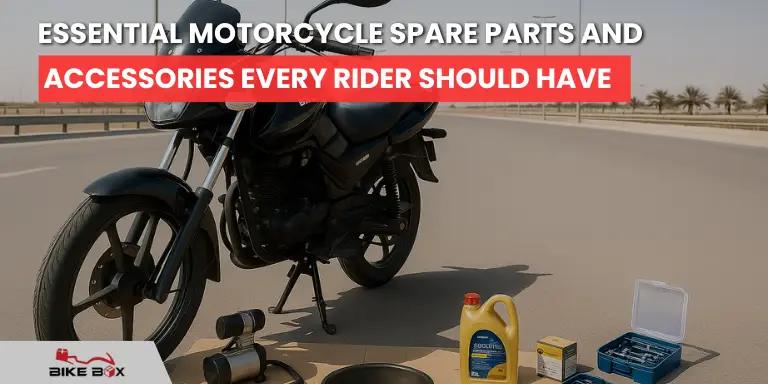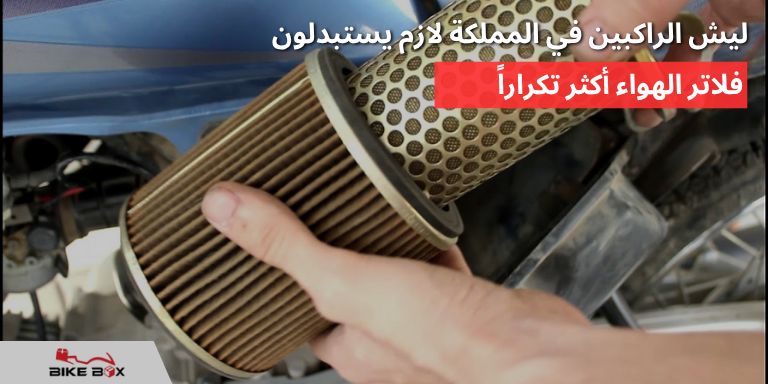When you press your motorcycle’s brake lever, the brake pads stop the bike by creating friction against the brake disc. If your brake pads are weak, old, or the wrong type, your bike would not stop properly.
In Saudi Arabia, the roads are hot, dusty, and many bikes, especially delivery motorcycles, cover long distances every day. The heat and dust wear out brake pads faster than usual. This makes your brakes feel soft, makes stopping harder, and can cause accidents.
This is the exact reason, choosing the right brake pads is important.
What Are Brake Pads?
Brake pads are the friction material that presses against your motorcycle’s brake disc to slow down or stop your bike. Every time you squeeze your brake lever, these pads clamp onto the disc, generating the stopping power you rely on.
When they wear out, braking gets weak, dangerous, and unpredictable, especially in extreme heat or dusty conditions.
Types of Brake Pads for Motorcycles in Saudi Arabia
There are four main types of brake pads. Each one works better in different riding conditions. For a deeper understanding of each type, including their pros and cons, you can visit our Complete Brake Pads Guide.
1. Organic Brake Pads
- What They Are: Made from natural materials like rubber, glass, and resins.
- Best For: City riding and light bikes in cooler or moderate temperatures.
- Not Recommended For: Desert highways or high-speed riding in warm weather.
2. Sintered Brake Pads
- What They Are: High-performance pads made by fusing metallic particles under heat and pressure.
- Best For: High-speed riding, heavy bikes, and hot weather.
- Ideal In: Riyadh highways, long delivery routes, heavy superbikes.
3. Ceramic Brake Pads
- What They Are: Made from ceramic compounds and copper fibers.
- Best For: Premium bikes, clean braking, less dust, and smooth performance.
- Ideal In: Moderate temperatures and urban traffic where brake dust is a concern.
Semi-Metallic Brake Pads
- What They Are: A mix of metal shavings and synthetic materials.
- Best For: Balanced performance in mixed weather.
- Ideal In: Jeddah’s coastal cities with occasional rain and humidity.
Choosing the Best Brake Pads for Your Motorcycle in Saudi Arabia
Choosing the right brake pads isn’t about guessing or following what someone else uses. It depends on how, where, and how much you ride. Let’s break it down clearly:
1. Check Your Riding Style
Start by thinking about how you use your bike daily. Are you riding long routes on highways or sticking to short trips inside the city?
If you ride long distances, especially on highways or carry heavy loads on delivery bikes, you need brake pads that can handle heat and pressure. Sintered brake pads are the best choice here because they stay strong even in extreme heat and last longer under tough use.
On the other hand, if you mostly ride within the city, stopping and starting in traffic, or cover light distances without heavy loads, you can safely use semi-metallic or ceramic brake pads. These offer smooth braking and decent durability for short, controlled rides.
2. Consider Saudi Weather and Road Conditions
Saudi roads are tough on brake pads. High temperatures, dust, and sand wear them out quickly. That’s why the type of brake pad you choose has to suit this environment.
Sintered and semi-metallic brake pads work better in Saudi conditions. They resist heat and dust buildup, giving reliable braking even during long, hot rides.
Organic brake pads, however, wear out too fast in this weather. The material softens under heat and loses grip. It’s better to avoid these for bikes in Saudi Arabia.
3. Know Your Bike Model
Not all brake pads fit every motorcycle. The size, shape, and friction rating of pads differ from one bike model to another.
Before you buy, check your motorcycle’s manual or look at the old brake pad number stamped on it. That number ensures you get the exact fit your bike needs.
If you are unsure, Bike Box stocks exact-fit brake pads for popular bikes in Saudi Arabia like Bajaj Boxer, TVS HLX, Hero, and Honda motorcycles. You can get genuine and high-grade aftermarket options for both single bikes and delivery fleets.
4. Balance Between Price and Performance
Not every situation requires the most expensive brake pads. The smart way is to match your brake pad to your actual usage and budget.
If you ride long routes daily, carry heavy loads, or often ride at high speeds, it makes sense to spend a little more on genuine or sintered brake pads. These offer longer life and reliable performance.
But if your rides are short, inside the city, or light-duty, you can save money by choosing high-grade aftermarket brake pads. These can give decent performance if you maintain your bike regularly and don’t push it to extremes.
Important: Avoid buying the cheapest, unbranded options you find at street markets. Low-quality pads wear out quickly and can fail when you need them most. It’s always better to spend a little more for something reliable.
5. Check for Quality Marks and Heat Ratings
Before buying any brake pad, check its packaging and surface for proper heat-resistance ratings, friction grade labels, and brand markings.
Quality pads usually have certifications or markings that show they’ve been tested for heat and durability. If a brake pad has no markings, no brand name, and comes in a loose plastic bag, skip it no matter how cheap it is.
Buying from a trusted supplier matters because brakes are your bike’s lifeline. Certified high-grade aftermarket pads from reliable sellers can perform well, but counterfeit copies are a risk.
Choosing brake pads isn’t complicated once you understand your needs, your bike’s requirements, and Saudi Arabia’s road conditions. Always buy brake pads that match your riding style, can handle the local heat and dust, and come from a trustworthy supplier.
When unsure, ask your mechanic or visit a certified workshop like Bike Box, where experts can guide you on the exact brake pads your bike needs — whether you prefer genuine or high-grade aftermarket parts.
When to Choose Aftermarket Brake Pads and When to Choose Genuine?
Brake pads come in two main options: genuine (original) and aftermarket. Both have their place, but it depends on how you use your bike, your budget, and how often you maintain your vehicle. Here’s a clear breakdown to help you decide.
When to Choose Genuine Brake Pads?
Genuine brake pads are made by or for the bike’s original manufacturer. They’re designed to match your bike’s braking system perfectly, offering reliable stopping power and consistent performance.
You should choose genuine brake pads when:
- You ride long distances daily, especially on highways
- Your bike carries heavy loads, like delivery boxes or cargo racks
- You ride in extreme Saudi heat and need your brakes to hold up under pressure
- You prefer longer-lasting pads that require fewer replacements
- Your bike is still under warranty, and you want to keep it protected
Genuine pads may cost more upfront, but they often save money in the long run by lasting longer and protecting other brake parts like discs and calipers from damage.
When to Choose Aftermarket Brake Pads?
Aftermarket brake pads are made by other manufacturers. Some are low-quality copies, but many are high-grade, certified parts that perform well when chosen wisely.
You should consider aftermarket brake pads when:
- Your bike is used for short, low-speed rides inside the city
- You have a large delivery fleet and need to manage maintenance costs smartly
- You regularly check and replace brake pads as part of your routine
- You find certified, high-grade aftermarket pads from a trusted supplier
- The price of genuine brake pads is too high for the bike’s purpose, like a backup or light-use vehicle
Good aftermarket brake pads can be a smart, cost-effective option if you avoid cheap, untested copies. Always look for heat-resistant, certified pads designed for your bike model.
Note
Not all aftermarket pads are safe. Loose, unmarked brake pads sold in markets or online without clear brand names or heat ratings should be avoided. The few riyals you save upfront can lead to costly brake failure later.
Stick to trusted brands and suppliers like Bike Box, which stock both original and high-grade aftermarket brake pads for motorcycles in Saudi Arabia.
Where to Get Reliable, Original Brake Pads in Saudi Arabia?
When you rely on your motorcycle for daily rides or delivery jobs, you should not make a compromise on your brake pads. Bike Box is one of the most trusted suppliers in Saudi Arabia, offering original brake pads for Bajaj Pulsar, Boxer BM 150, TVS HLX, Hero, and Honda motorcycles.
You can order online, call, or visit their workshops at Sulay or Rimal in Riyadh for brake pads spare parts in Saudi Arabia. Bike Box also offers full brake pad fitting and repair services, which is why delivery companies with large fleets count on them to keep their bikes running safe and sharp.
Conclusion
Choosing the right brake pads is important in Saudi Arabia’s harsh riding conditions. Heat, sand, and long-distance rides wreck weak pads fast. Stick to the right type, stay alert for wear signs, and choose the brake pads suitable for you in the long run.
Book your brake pad replacement with a trusted supplier like Bike Box and ride safer, stronger, and smarter.
Frequently Asked Questions
Q1: How often should I change my motorcycle brake pads in Saudi Arabia?
In Saudi Arabia’s high heat and dusty roads, brake pads typically last 8,000 to 15,000 km, depending on your riding style, route, and bike type. Delivery bikes running daily long-distance routes may need replacements even sooner. Always inspect your pads every 5,000 km for wear signs.
Q2: Which brake pad type is best for long-distance delivery bikes in KSA?
Sintered brake pads are the top choice for long-distance delivery bikes in Saudi Arabia. They handle high temperatures, resist fade during long rides, and offer stronger braking under heavy loads compared to organic pads.
Q3: How can I tell my brake pads are worn out?
Look out for a soft or spongy brake lever feel, screeching or squealing sounds, weak braking in wet conditions, visible thin or glazed pads when inspected. If you spot any of these, replace them immediately.
Q4: Can I replace my motorcycle brake pads myself in Saudi Arabia?
You can, if you have the tools, experience, and a cool shaded space to work in. But for safety, delivery bike fleet owners and serious riders prefer professional fitting at workshops like Bike Box to avoid faulty installations.
Q5: Where can I buy original brake pads for Bajaj Boxer, TVS HLX, Hero, or Honda bikes in Saudi Arabia?
You can order original brake pads online through Bike Box’s website, place order via call or WhatsApp, or visit their workshops in Riyadh, Saudi Arabia. Bike Box also provides professional brake pad fitting and repair services as well trusted by many delivery fleet owners across KSA.
Q6: Are ceramic brake pads good for Saudi riding conditions?
Ceramic brake pads perform well in moderate heat and urban traffic, offering clean, dust-free braking. However, for extreme temperatures or heavy-duty delivery work, sintered or semi-metallic pads are better suited for the job.
Q7: Do high temperatures in Saudi Arabia affect brake pad performance?
Yes. Intense heat causes brake pads to fade, lose bite, and wear faster, especially if they’re cheap or not heat-rated. That’s why riders in Saudi Arabia should always choose high-quality sintered or semi-metallic pads for consistent, safe braking.




